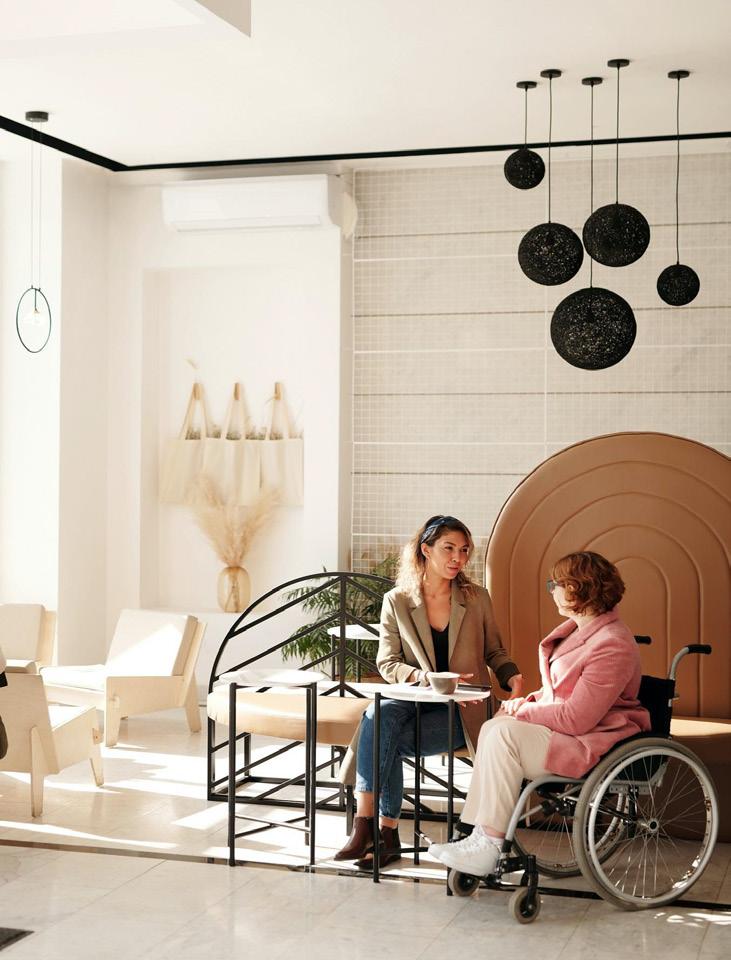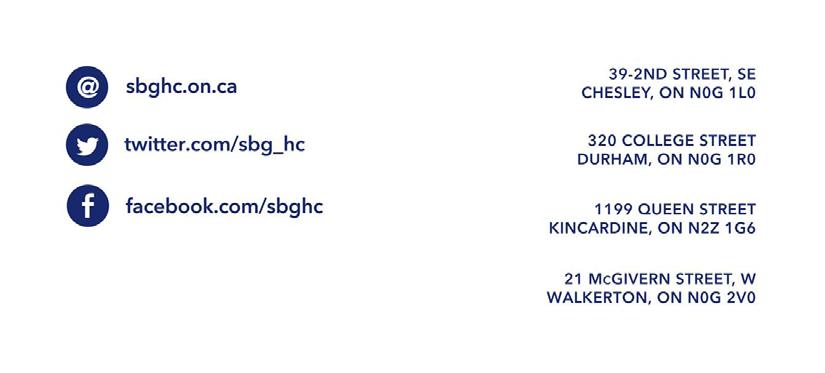






South Bruce Grey Health Centre (SBGHC) is a multi-site hospital organization serving four rural communities in southern Bruce and Grey Counties. Our team of 400 dedicated professionals are committed to providing quality health care close to home.
Our goal is to make positive patient experiences and good health outcomes the focus of everything we do. We have prepared this directory to help better acquaint you with our hospitals and to make your stay with us as comfortable as possible. If you have any questions, please do not hesitate to ask your care provider.


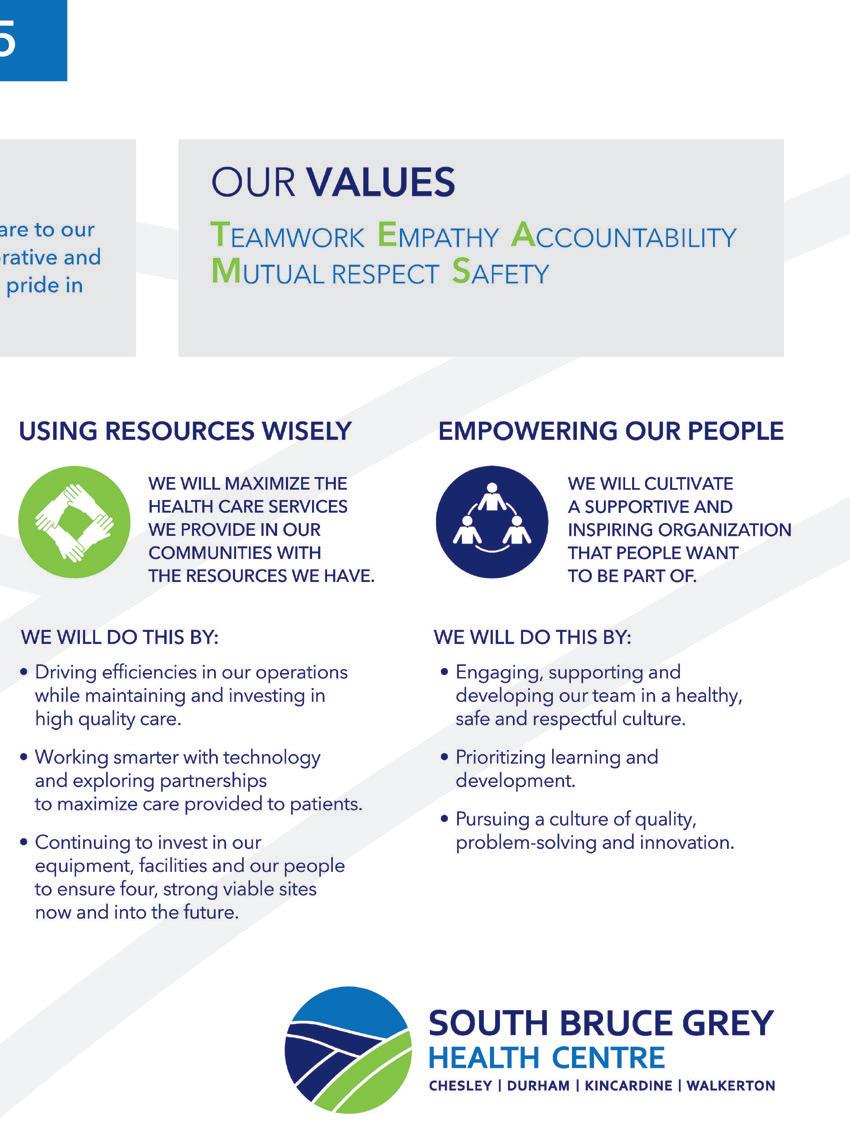
One of the keys to getting the best health care is to be an active member of your health care team. This means taking part and being involved in every decision about your care. This also means asking questions of your health care team so that you can make informed choices, come prepared for your medical treatments, and know what to do when you go home.
You should understand as much as you can about:
• Your medical condition
• Treatments or procedures you will have
• Medication you should take and how to take it
Here are some good questions to ask:
• “What should I do when I go home?”
• “What do I need to plan for when I am discharged?”
• “What should I tell my family about my care?”
• “Can you tell me more about my medical problem?”
• “What does this test or treatment involve?”
• “What is the purpose of this test or treatment?”
• “Are there any other options?”
• “What should I do (or not do) to get ready for a procedure?”
Tell a member of your health care team about your past illnesses and your current health condition. You are the one who knows the most about your health. Tell the members of your health care team everything you can, even if you think they already know, and even if you think it is not important.
The whiteboard in your patient room is used by your health care team to communicate information about your care. Whiteboards are updated every shift to include the current date, name of the most responsible nurse, your individual mobility status, and risk level for falls and pressure injuries. Please ask your nurse about your individual risk for falls and pressure injuries and how you and your family can be involved in prevention strategies.
South Bruce Grey Health Centre is committed to protecting the privacy of personal health information. The collection, use, disclosure and management of personal health information is governed by Ontario’s Personal Health Information Protection Act (PHIPA). To request access to these records or to correct your personal health
information, you can complete an access request available through the Health Records Department. You can reach Health Records at ext. 2213.
As we are committed to ensuring that your privacy is protected, we take all necessary steps to comply with PHIPA and to safeguard your information. To learn more about the hospital’s use and disclosure of personal health information, please visit our website.
South Bruce Grey Health Centre greatly values the feedback we receive from our patients and families, and use it whenever possible to improve patient care experiences.
If you have a concern regarding your experience, or a suggestion for improvement, we would like to hear from you.
We encourage you to discuss your concern with your care provider or the Department Manager as a first step. If you are unable to resolve your concern, please contact the Patient Relations Office and we would be happy to assist you.

Our Patient Relations Office will gather information to investigate your concern and work with you through the resolution process.
If you would like to share a positive experience with us, we will make sure that your care team is recognized for their efforts to provide a positive patient experience.
Meghan Legge Patient Relations Office (519) 370-2400 ext. 2281 patientrelations@sbghc.on.ca
We encourage you to complete a Patient Experience Survey upon discharge from the hospital.You may receive an invitation to complete a survey by email or text message, or you can complete an electronic version of the survey on our website (www.sbghc. on.ca/patients-visitors/patient-experience-survey/).
Who is at risk for falling?
• Individuals with a recent history of falling or near falling
• Individuals who are unsteady on their feet or have problems with balance or mobility
• Individuals who experience confusion
• Individual on multiple medications or medications that may cause drowsiness or fatigue
If the falling leaf symbol is displayed on your whiteboard, your health care team has determined that you are at risk for falling. Extra precautions will be taken to ensure your safety.
How you can help prevent falls
• Use the call bell when you need help.

• Ask your care provider for help to and from the bathroom. This is very important if you are unsteady. The call bell in the bathroom is located on the wall.
• For your safety, a member of your care team may stay with you in the bathroom.
• If you take medicines that cause you to go to the bathroom often, ask for help when you need to get up. Consider using a commode or urinal.
• Some medicines may cause you to feel dizzy or sleepy. Take your time getting out of the bed or chair. Sit at the edge of the bed for a few seconds before you get up.
• Wear nonslip footwear or slippers when you are up.
• Wear your eyeglasses and/or hearing aid(s) when you are awake.
• Walkers and canes can provide support. Other items do not. Do not lean on the bedside table, furniture, IV pole or other items to steady yourself.
• Ask a member of your care team to place the call bell, phone and personal items within your reach before he or she leaves the room.
• Tell a member of your care team if you have any concerns about your safety.
Patient safety and comfort are important to the entire health care team. Family and friends can also help by doing the following:
• Make sure the call bell, phone and personal items are within easy reach of the patient before you leave the room.
• Call the nurse if the patient is weak or light headed.
• Consider staying with the patient if he or she is confused or at a high risk of falling.
• Call the nurse before leaving the patient if he or she is confused.
• Remind the patient to ask the nursing staff for help when getting up. If you have any questions, please ask a member of your health care team.
Fire exits are clearly marked throughout the building. In the event that the fire alarm sounds, please stay in your room and await instructions from staff. Fire drills are conducted routinely for your added safety.
Latex balloons are not permitted in the hospital. In accordance with our scent free policy, fragrant flowers (such as lilies and hyacinths) are not permitted in patient care areas.
When visiting the hospital, please make use of the waterless alcohol based hand rub that can be found throughout the building. It is the most effective way of cleaning your hands to prevent the spread of infection.
Hourly checks are incorporated in our daily care. Your nurse will come to check on you regularly to see if you need assistance with repositioning in your bed or chair, assess and manage any pain you may be having, provide any personal care, ensure your personal belongings are within reach, assess hospital equipment that is being used, such as IV pumps and will let you know when they will be back to see you again.
During your stay in hospital you may receive medications or fluids by a medication infusion pump. In most cases, an intravenous is inserted into your arm and the medications or fluids are then delivered directly into your vein. The pumps have many safety features, and nursing staff are trained on how to utilize the pumps safely. Alarms may sound on your pump to indicate various different things, and it is important not to press buttons or attempt to make any adjustments on your own. Please notify your nurse if you have any questions or concerns regarding your infusion pump.
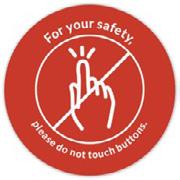
Throughout your hospital stay, your care team will actively engage with you on your treatment plan and medications. Information regarding any new medications being started or stopped will be reviewed with you, including details regarding the purpose of the medication, schedule, change in dose, and potential side effects.
Upon admission, staff will collect a ‘best possible medication history’. This information will be gathered from a combination of the medication list and/
or medications brought with you to hospital, a list provided by your community pharmacy, and/or previous medications lists. It is extremely helpful when patients bring the pill bottles the pharmacy provided your medications in (vs. dosettes or other containers you have poured your medications into), which makes the medication, dosage and schedule of medications very clear to the care team. This provides your care team with the most accurate information regarding what medications you were taking prior to coming to hospital, so your physician is able to continue these medications while in hospital, or make changes as necessary. It is important that you do not take additional medications from your own supply while in hospital, and that all medications will be administered and documented by hospital staff to ensure the safest care possible. If you have any questions regarding storage of medications or whether to send medications home please speak with your nurse.
To ensure safety, staff will routinely verify your identification before administering any medications, utilizing both your patient wristband and asking you your name and date of birth.
If you have any questions or concerns, or would like any additional information regarding the medications you are receiving while in hospital, please speak with your physician or nurse.
A pressure ulcer or “bed sore” is an injury to the skin caused by continuous pressure, most typically on the heels, hips, tailbone and elbows.
Ways we work together to prevent pressure injuries while in hospital
• Reposition in bed every 2 hours, get up to chair and ambulate as appropriate. Be sure to ask for assistance if you cannot do this safely on your own or your nurse has advised you to use your call bell when getting out of bed.
• Use of specialized equipment, such as air mattresses, heel boots, cushions.
• Mobility activities with physiotherapy and nursing.
• Proper nutrition – eating and drinking enough while in hospital.
• Inform your nurse if your skin is feeling wet or damp or you have been incontinent.
• Speak to your nurse if you notice and changes to your skin or have any questions or concerns.
When seniors are hospitalized, they become vulnerable to unexpected challenges including hospital acquired delirium and functional decline that complicate their ability to return to their place of residence. Our staff are trained in completing assessments for delirium and functional decline for patients greater than 65 admitted to our hospital.
South Bruce Grey Health Centre is striving be a scent free environment. Please refrain from wearing scented products, such as perfumes and colognes, and bringing strongly scented flowers into the hospital.
As part of our commitment to the health of our patients, visitors and health care workers, our buildings and properties are 100% smoke free.
Smoking is not permitted indoors or outdoors on any property owned by South Bruce Grey Health Centre, including parking lots, walkways and lawns.
Thank you for supporting a healthy environment.
Hospital staff and volunteers are easily identified by their photo identification badge. Please notify a staff member immediately if you observe any suspicious activity or individuals, or if you have any security concerns.
Venous thromboembolism (VTE) is a condition that includes deep vein thrombosis (DVT) and pulmonary embolism (PE). A DVT is a blood clot, also called a thrombus, that occurs in a deep vein. It usually occurs in the leg but can also occur in the pelvis, arm, or neck.
How can this condition affect me?
VTE is a serious health condition that can cause disability or death. It is very important to get help right away. Do not ignore your symptoms.
What actions can I take to prevent this?
• Complying with the administration and use of medications that are prescribed to prevent blood clots while in hospital.
• Get out of bed and walk. This keeps blood moving through the veins, which decreases the risk of developing VTE. Ask your health care provider if this is safe for you to do.
• Ask your health care provider if you should use a sequential compression device (SCD). This is a machine that pumps air into compression sleeves that are wrapped around your legs.
• Ask your health care provider if you should wear tight, elastic stockings that apply pressure to the lower legs (compression stockings). Compression stockings are sometimes used with SCDs. All patients admitted to SBGHC will be screened for the risk of VTE. Your physician will review your individual risk and specify the appropriate prophylaxis and interventions required during your stay based on your level of risk.
South Bruce Grey Health Centre is committed to identifying, removing and preventing barriers for people with disabilities who visit, work in or use our hospitals. More information on our annual accessibility plan is available on our website. We welcome feedback on the accessibility of our facilities. Please contact: Patient Relations Office (519) 370-2400 ext. 2281 patientrelations@sbghc.on.ca
Our Patient Registration staff will make every effort to provide you with the type of accommodation you request. Our hospital provides standard ward, semi-private, and private rooms. Semi-private and private rooms (if requested by you) are available for a fee and must be paid by you or your insurance provider. If you have insurance coverage, please let our staff know.
The use of cellular phones and wireless devices is permitted within our facilities, however, we ask that they be operated in silent or vibrate mode to limit disruption to others. To protect the privacy of our patients and visitors, photos are not permitted within patient care areas.
You may be asked to sign a consent form for certain tests, procedures and treatments, including transfusions of blood and blood products. Before signing, ensure you know the benefits and risks of having treatment and the risk(s) associated with not having the treatment(s). If you need more information or have questions before signing, consult your care provider.
Ethics and values play a role in many of the decisions made in healthcare. To assist our staff and physicians with making these decisions, an Ethics Consultant and Ethics Committee are available as a resource to assist with decision making in the hospital as needed.
For more information, please ask your care provider.
South Bruce Grey Health Centre has paid parking which costs $3.00 per exit (including applicable taxes). VISA, MasterCard, and Interac Debit cards are the only payment methods accepted at the pay stations and gate exits. There are indoor parking pay stations located at the hospital entrance, or you can pay at the gate. In the event that you are required to attend South Bruce Grey Health Centre on a frequent basis, 10 and 30 day passes can be obtained at Patient Registration for a reduced rate.
Revenue generated from parking is incorporated into South Bruce Grey Health Centre’s overall budget and helps with maintenance costs for snow removal, resurfacing and general parking lot repairs.
• Ontario Health Card – Your Ontario Health Insurance Plan (OHIP) will cover all of your in-hospital costs except for:
• Preferred accommodation (semi-private or private accommodation)
• Telephone
• Television
• Non-urgent transportation
• Other Health Insurance Cards (supplementary insurance information)
• Medications
• Please bring a list of your current medications.
• Your own medications, if not required during your admission, will be sent home with a family member as storage space is very limited at the hospital and we do not have a secure location for narcotics.
• If you are to continue on a medication that is not available at the hospital, your own medications will be issued to you. You may be asked to arrange for a family member to bring these medications to the hospital.
• You are requested not to self-administer medications while in hospital. It is important that the physician knows what medications you are on.
• You are responsible upon discharge to ensure you have your home medications. Please give all of your medications to the nurse and we will return them when you are discharged.
• Please tell your doctor and nurse if you are allergic to any medications or suffer from any other allergies.
• If you have any questions about your medications,your doctor, nurse, or hospital pharmacist will assist you.
• Personal items - You should bring only necessary personal toiletry articles such as a toothbrush, toothpaste, comb and brush, shaving items, or cosmetics (no scented products). Although the hospital provides patient gowns, you may want your own pajamas or nightgown, bathrobe, slippers, etc. Bring your own mobility aids (cane, walker) including proper fitting shoes and slippers.
• Mobility Aids – Please bring your own mobility aids (wheelchairs, walkers). If patients require mobility aids in hospital and do not have their own, we have a small supply to borrow for hospital use. Hospital mobility aids are not to be removed from hospital property unless a waiver is signed. If you are waiting in hospital for long-term care, you will be expected to provide your own equipment. Please do not bring: valuable papers or documents, scented personal care products, items of sentimental value, jewelry or expensive clothing, large amounts of cash, alcoholic beverages, TV, DVD players, radios, or plug-in appliances unless otherwise approved by staff.
The hospital cannot accept responsibility for lost, stolen or damaged personal articles and/ or money. If you are unable to send valuables home, please request that your item(s) be placed with Patient Registration for safekeeping.
Your health care team will assess your discharge needs from the time you are admitted as a patient. Questions regarding your health care will be answered before discharge. Prescriptions and follow up appointments, if necessary, will be given on the day of discharge.
Sometimes it can be hard to get the care you need - lots of people to see, appointments to go to, and information to share. It may be hard to keep track of it all. Maybe you have health needs that are not being met or you don’t know how to get help. Perhaps, you feel that what matters most to you is not being heard. Coordinated Care Planning can help.
Coordinated Care Planning is a way to bring your Care Team together to create a Care Plan that is right for you. The Care Plan will include what is important to you, what your needs are, and how your Care Team will work together to keep you as well as possible. The Care Plan will be shared with you and all Care Team members so everyone has the right information at the right time. Over time, your care needs might change so your Care Plan and Team may change too.
Your Care Team is made up of people helping you with your care. It may include your doctor, nurse, pharmacist, social worker, family, or friend - anyone helping with your care. One person on the Care Team will be in charge of sharing information with
you and the rest of the team – that way, you will know who to call when you have questions about your Care Plan.
For more information on Coordinated Care Planning, please speak with a member of your care team.
SBGHC’s Family Presence Policy allows patients to identify their Partner in Care to support them continuously throughout their hospital stay. Please check our website or ask a member of your care team for up to date information on visiting a patient.
South Bruce Grey Health Centre is proud to offer Meals Your Way, an expanded patient menu offering a variety of choices at each meal time. Staff will take your order in advance of your meal (orders for breakfast will be taken after dinner, orders for lunch will be taken after breakfast, orders for dinner will be taken after lunch). Please be sure to have your order ready at these times. Upon admission, you will be asked about any diet restrictions or allergies. Your diet is ordered by your physician.
Meal Service Times:
Breakfast: 8:00-8:30 AM Lunch: 12:00-12:30 PM Dinner: 5:00-5:30 PM
Vending machines are available at all sites.
Incoming mail will be delivered to your room daily and outgoing mail can be left at the Registration desk. Any mail received after your discharge will be sent to your home address.
Animals may be brought into the hospital under the following conditions:
• The animal is a designated service animal.
• The animal is part of the St. John Ambulance Therapy Dog Program or similar approved program.
• It is deemed that a short visit by a personal pet would be beneficial for the patient. Animals must have vaccinations up to date. Please ask your care provider for more information.
We believe in the importance and value of providing spiritual care for patients and families and promote independent patient choice for receiving spiritual care. Our staff are happy to assist you in contacting your spiritual care provider if assistance is required. You may also wish to contact your spiritual care provider on your own or with family assistance.
A daily rate applies for telephone hookup and patients are responsible for long distance charges. For local calls, dial 9 to get an outside line.
Please call Patient Registration to assist you in making long distance calls:
Chesley: 7504
Kincardine: 7503
Entertainment
Durham: 7505
Walkerton: 7501
A tablet is available at the bedside that offers TV, radio and resources such as patient education, meal selections and patient experience surveying.
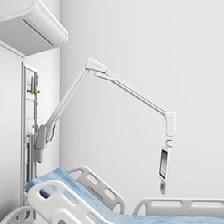

If you have difficulty connecting, please request a Wi-Fi Connection Quick Guide from a member of your care team, or contact the Patient Relations Office for assistance (patientrelations@sbghc.on.ca).
Physicians and nurse practitioners in Ontario can provide medical assistance in dying. Learn if you are eligible for this option and how and where you can receive it. www.ontario.ca/page/medical-assistance-dying-and-end-life-decisions
Ontario Health (Trillium Gift of Life Network), an agency created by the Government of Ontario, is responsible for planning, promoting, coordinating and supporting organ and tissue donation across Ontario and improving the system so that more lives can be saved.
As a designated reporting site, SBGHC is required to notify the Trillium Gift of Life Network within one hour of a patient’s death. When a call is made, TGLN will screen to determine if the patient is medically suitable for donation and connect with the family to discuss the opportunity and obtain consent for those that qualify. When tissue or organ donation is possible, the TGLN team will come on site to recover the tissue or, in rare circumstances, coordinate transportation of the patient to an alternative site for tissue/organ recovery.
Every three days, a person dies waiting for an organ transplant. By registering to become an organ and tissue donor, your death has the power to save or change someone’s life.
You can register:
• Online at beadonor.ca
• In person at any Service Ontario centre
• By mailing the Organ and Tissue

Donor Registration form available at beadonor.ca/register Register, then talk to your family
By registering your consent to donation now, you save your family the burden of making the decision for you. After you’ve registered, talk to your family about your decision to save lives.

I will be treated, and treat other s, with respect and under standing.
I will be encouraged to communicate clearly and openly with my team about my care and my needs.
I am able to identify the significant people in my life that I want to have par ticipate as par tner s in my health care journey.
I will receive treatment that is safe, ef fective and confidential.
Putting patients fir st.
Living our core values – T Teamwork , E Empathy, A Accountability, M Mutual Respect and S Safety.
Communicating regularly with patients and families to ensure their questions and concerns are addressed.
Introducing our selves to patients and families and ensuring our name badges are displayed prominently.
PED IN CONSULTATION WITH SOUTH BRUCE GREY CENTRE’S PATIENT AND FAMILY ADVISORY COUNCIL.
Southwesthealthline.ca is an online resource that provides accurate and up-to-date information about health services in your community. Select the Grey Bruce tab at the top of the page and search by health care topic.
• Home and Community Care
• Pharmacies, Medical Labs and Diagnostics
• Diabetes and Stroke Services
• Caregiver Supports
www.southwesthealthline.ca
• Long-Term Care and Retirement Homes
• Social Supports and Basic Needs
• Mental Health and Addictions Services
If you have lost an item or are reporting a found item, please contact Patient Registration.
It is the responsibility of the patient and/or family to arrange and pay for transportation home when you are discharged from South Bruce Grey Health Centre after an emergency visit, appointment or hospital stay. This includes transportation to long-term care facilities and pre-booked appointments.
Transfer to another hospital for care related to your current admission remains the responsibility of South Bruce Grey Health Centre.
If a family member or friend is not able to provide transportation home, there are several service providers available for a fee.
Private Stretcher (vehicles that provide stretcher service)
• Voyago .................................................................................. 1-855-263-7163
• Hoffman’s ............................................................................. 1-877-237-3631
• Huron Patient Transfer ..................................................1-877-286-5906
• Cross Country ......................................................................1-877-615-1030
Other (vehicles that provide wheelchair service)
• Voyago ........................................................................................................... 1-855-263-7163
• Saugeen Mobility and Regional Transit (SMART) .................1-866-981-2504
• Moving Grey Bruce ...................................................................................1-888-660-6048
Taxis
You can ask Patient Registration or a nurse to call a taxi for you or give you the numbers of local providers. This service will be used at your expense.
(available 24/7)
For information on free mental health walk-in clinics, visit the Canadian Mental Health Association (CMHA) Grey Bruce website. www.greybruce.cmha.ca/mental-health-services/drop-in-clinic
Wes for Youth - free, ongoing, one-on-one counselling support with a professional counsellor. www.wesforyouthonline.ca
If you are interested in partnering with SBGHC to improve patient and family experience and quality of care, we have two opportunities available for you to consider.
SBGHC’s Patient and Family Advisory Council meets six times per year to share ideas and have discussions about how to improve patient and family experience and quality of care. If you have had a recent experience as a patient or family member/ caregiver and are interested in joining as a Patient and Family Advisor, please reach out!
SBGHC’s Hospital Advisors help to improve patient and family experience and quality of care with a flexible time commitment. As a hospital advisor, we may reach out to you to ask you a question, or fill out a brief survey or tour you through the hospital to get your input on potential improvements. If you are interested in becoming a hospital advisor, please reach out!
For more information, please contact patientrelations@sbghc.on.ca
South Bruce Grey Health Centre’s supporting Foundations work within our communities to raise funds for equipment and upgrading our facilities. Your support enables us to continue to provide the best possible care close to home. For information on donations, bequests, or volunteering, please contact your local Foundation.
Chesley Hospital Foundation: Telephone: 519-363-2340 www.chesleyfoundation.ca
Durham Hospital Foundation: Telephone: 519-369-2340 ext. 5267 www.durhamfoundation.ca
Kincardine and Community Health Care Foundation: Telephone: 519-396-3331 ext. 4342 www.kincardinefoundation.ca
Walkerton & District Hospital Foundation: Telephone: 519-881-0441 www.walkertonhospitalfoundation.com
Disclaimer: We thank all the advertisers whose support has made this publication possible. The appearance of the advertisements in this publication should not be taken as an endorsement by our hospital of any particular goods or services and our hospital cannot be responsible for the goods and services which appear in those advertisements.

















